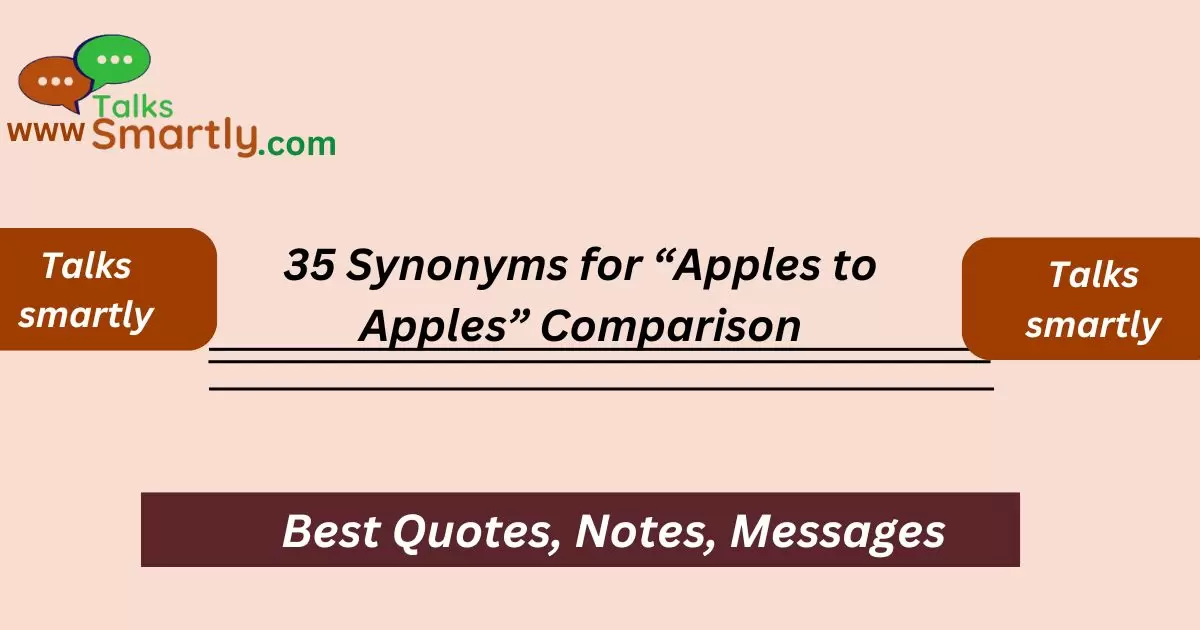Comparing two items on equal footing is essential for accurate evaluation. The phrase “apples to apples” signifies a fair comparison between similar entities.
When comparing items or concepts, ensuring that the comparison is fair and equivalent is crucial. The term “apples to apples” is often used to indicate a straightforward and equitable comparison. Yet, there are many other ways to express this idea, each providing a different nuance or context.
In this blog post, we will explore synonyms and alternative phrases for “apples to apples” comparison. Understanding these alternatives can enhance your ability to communicate the concept of fair and equal comparisons in various settings.
By the end of this post, you’ll be equipped with a range of phrases that can be used in both formal and informal discussions to describe fair and comparable evaluations.
35 Synonyms for “Apples to Apples” Comparison
- Fair Comparison
- Like-for-Like Comparison
- Equal Terms Evaluation
- Comparable Basis
- Equivalent Comparison
- Direct Comparison
- Side-by-Side Analysis
- Same Basis Comparison
- Apples-to-Apples Evaluation
- Equal Grounds Comparison
- Matching Comparison
- Uniform Comparison
- Balanced Comparison
- Even Comparison
- Equivalent Grounds Evaluation
- Same Standard Comparison
- Level Playing Field
- Mirror Comparison
- Par Comparison
- Consistent Comparison
- Homogeneous Evaluation
- Fair Grounds Analysis
- Equal Comparison
- Same Metrics Comparison
- Standardized Comparison
- Equal Comparison Criteria
- Similar Basis Evaluation
- Uniform Basis Analysis
- Even Playing Field
- Aligned Comparison
- Commensurate Comparison
- Balanced Grounds Evaluation
- Same Level Comparison
- Comparable Evaluation
- Equal Basis Analysis
1. Fair Comparison
A straightforward term that implies both items being compared are on equal footing. It denotes an unbiased and equitable assessment.
Example: “We need a fair comparison to ensure that our results are accurate and unbiased.”
2. Like-for-Like Comparison
This phrase emphasizes comparing similar items or entities. It is often used in contexts where the items are similar in nature and function.
Example: “For a like-for-like comparison, we should use products from the same category.”
3. Equal Terms Evaluation
Indicates that the comparison is made on equal conditions or criteria. This term is useful when assessing items with the same set of standards.
Example: “The equal terms evaluation will help us understand the true value of each option.”
4. Comparable Basis
This phrase highlights that the comparison is based on similar criteria or standards. It suggests that both items are evaluated under the same conditions.
Example: “We need to ensure that we use a comparable basis for our analysis to get accurate results.”
5. Equivalent Comparison
A term used to describe a comparison where the items being evaluated are of equal value or standard. It implies that both items are on the same level for a valid assessment.
Example: “An equivalent comparison will help us determine which option is better.”
6. Direct Comparison
Refers to comparing two items directly against each other without any intermediary factors. It signifies a straightforward approach to comparison.
Example: “A direct comparison of these two models will highlight their differences clearly.”
7. Side-by-Side Analysis
This term involves comparing items directly next to each other for easy visual and functional comparison. It’s useful for detailed evaluations.
Example: “The side-by-side analysis of the products reveals their distinct features.”
8. Same Basis Comparison
Indicates that the comparison is made on the same foundational criteria or terms. It ensures that both items are assessed under identical conditions.
Example: “We should use a same basis comparison to ensure fairness in our review.”
9. Apples-to-Apples Evaluation

Similar to “apples to apples” but can be used interchangeably to emphasize fair comparison. It conveys that both items are assessed equally.
Example: “The apples-to-apples evaluation will give us a clear picture of their relative merits.”
10. Equal Grounds Comparison
Emphasizes that the comparison is made on the same grounds or criteria, ensuring fairness. This term is useful for highlighting fairness in evaluation.
Example: “Using equal grounds comparison, we can ensure that our decision is based on objective criteria.”
11. Matching Comparison
Describes a comparison where items are matched in terms of features or criteria. It suggests that both items are evaluated based on similar aspects.
Example: “A matching comparison will help us identify the best option by focusing on key similarities.”
12. Uniform Comparison
This term implies that the comparison is made uniformly, with consistent criteria across items. It ensures that all factors are considered equally.
Example: “The uniform comparison approach helps in maintaining consistency in our analysis.”
13. Balanced Comparison
Indicates that the comparison is made with equal weight given to all relevant factors. It ensures a fair and even evaluation process.
Example: “A balanced comparison will allow us to consider all important aspects equally.”
14. Even Comparison
A term that suggests the comparison is made without bias or favoritism, ensuring equal consideration for all items. It highlights fairness in the evaluation process.
Example: “An even comparison of the options will help us make a well-informed decision.”
15. Equivalent Grounds Evaluation
Refers to evaluating items based on equivalent criteria or standards. It ensures that the comparison is made on equal terms.
Example: “The equivalent grounds evaluation ensures that our assessment is fair and unbiased.”
You Want to Help, but You Also Need to Protect Your Financial Well-Being
16. Same Standard Comparison
Describes a comparison where both items are judged according to the same set of standards or benchmarks. It implies uniformity in evaluation.
Example: “A same standard comparison will help us determine which option meets our requirements best.”
17. Level Playing Field
A metaphorical term indicating that all items are being evaluated under the same conditions, ensuring fairness. It is commonly used in various contexts to imply equal treatment.
Example: “We need a level playing field to make sure our comparison is fair and unbiased.”
18. Mirror Comparison
This term suggests that the items are compared as if they are mirror images of each other, highlighting similarities and differences clearly. It provides a direct comparison.
Example: “The mirror comparison approach will help us see how each product stacks up against the other.”
19. Par Comparison
Indicates that the comparison is made to ensure that items are evaluated on an equal level or standard. It conveys fairness in the evaluation process.
Example: “A par comparison will allow us to assess both options fairly and equally.”
20. Consistent Comparison
Describes a comparison where the criteria and standards are consistently applied across all items. It ensures uniformity and fairness.
Example: “We need a consistent comparison to ensure that all factors are evaluated equally.”
21. Homogeneous Evaluation
Refers to evaluating items in a way that ensures all factors are similar, providing a fair basis for comparison. It highlights uniformity in the evaluation process.
Example: “A homogeneous evaluation ensures that the comparison is based on similar attributes.”
22. Fair Grounds Analysis
Indicates that the analysis is conducted based on fair and equal grounds for all items being compared. It emphasizes fairness in the evaluation process.
Example: “Using fair grounds analysis, we can make a balanced and impartial decision.”
23. Equal Comparison
A straightforward term that conveys that the comparison is made on equal terms or criteria. It ensures that all items are evaluated fairly.
Example: “An equal comparison helps us to judge each option on the same level.”
24. Same Metrics Comparison
Describes a comparison using the same metrics or criteria for evaluation. It ensures that the assessment is based on uniform standards.
Example: “The same metrics comparison will provide a clear understanding of each option’s strengths and weaknesses.”
25. Standardized Comparison
Refers to a comparison where standardized criteria are used to evaluate all items. It ensures consistency and fairness.
Example: “A standardized comparison helps in making objective and comparable assessments.”
26. Equal Comparison Criteria
Highlights that the comparison is based on equal criteria for all items. It ensures that all factors are considered uniformly.
Example: “By using equal comparison criteria, we can make sure that all aspects are evaluated fairly.”
27. Similar Basis Evaluation
Indicates that the evaluation is made based on a similar basis or set of criteria. It ensures that the comparison is fair and equivalent.
Example: “A similar basis evaluation will allow us to compare the options on equal terms.”
28. Uniform Basis Analysis
Describes an analysis conducted on a uniform basis, ensuring all items are evaluated under the same conditions. It emphasizes fairness in the evaluation process.
Example: “The uniform basis analysis will help us compare the items on the same level.”
29. Even Playing Field
A term that metaphorically indicates that all items are being compared under the same conditions, ensuring fairness. It is useful for conveying equality in evaluation.
Example: “An even playing field is essential for a fair and unbiased comparison.”
30. Aligned Comparison
Refers to a comparison where all items are aligned with the same standards or criteria. It ensures that the evaluation is consistent.
Example: “An aligned comparison will help us see how each option measures up to the same standards.”
31. Commensurate Comparison
Indicates a comparison where items are evaluated based on commensurate or equivalent factors. It ensures fairness and equal treatment.
Example: “A commensurate comparison will ensure that each option is judged by the same standards.”
32. Balanced Grounds Evaluation

Describes an evaluation based on balanced and fair grounds, ensuring all factors are considered equally. It emphasizes impartiality in the assessment.
Example: “The balanced grounds evaluation will help us make a fair comparison of the options.”
33. Same Level Comparison
Refers to comparing items on the same level of criteria or standards, ensuring fairness. It ensures that all factors are evaluated equally.
Example: “A same level comparison allows us to judge each option fairly.”
34. Comparable Evaluation
Describes an evaluation where items are compared based on comparable criteria or standards. It ensures that the assessment is fair and relevant.
Example: “A comparable evaluation will help us understand how each option stands up to the same criteria.”
35. Equal Basis Analysis
Indicates that the analysis is conducted on an equal basis, with all items being evaluated under the same conditions. It ensures fairness and consistency in the comparison.
Example: “The equal basis analysis will ensure that all factors are considered fairly.”
ANSWERS TO KEY QUESTIONS
1. What does “apples to apples” comparison mean?
“Apples to apples” comparison means evaluating two items based on the same criteria or standards to ensure a fair and equivalent comparison.
2. When should I use alternative phrases for “apples to apples” comparison?
Use alternative phrases when you want to vary your language or when the context requires a different expression of fair comparison.
3. Can these synonyms be used interchangeably in all situations?
Most of these synonyms can be used interchangeably, but some might be more appropriate depending on the formality and context of the comparison.
4. How do I choose the right phrase for my comparison?
Consider the context of your comparison and the audience. For formal settings, terms like “equal terms evaluation” may be more appropriate, while casual settings might use “fair comparison.”
5. Are these phrases suitable for both professional and personal contexts?
Yes, many of these phrases are versatile and can be used in both professional and personal contexts to describe fair and equivalent comparisons.
Conclusion
Using the right phrase to describe a fair and equivalent comparison can enhance your communication and ensure clarity. By exploring these 35 alternative phrases for “apples to apples” comparison, you can find the most suitable term for your context.
whether in professional discussions or casual conversations. Each phrase offers a unique way to convey the idea of comparing items on equal terms, ensuring that your evaluation is clear, fair, and accurate.












